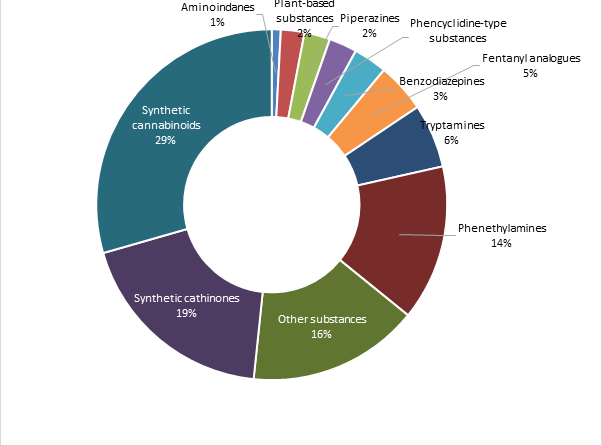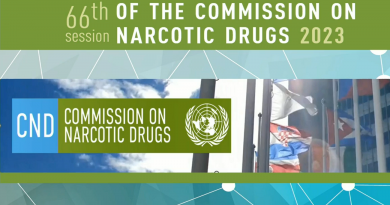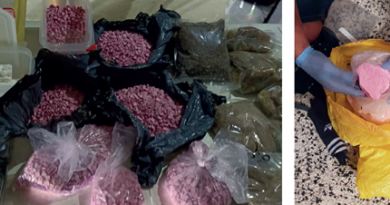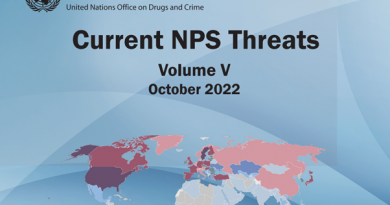UNODC EWA: Large seizures of synthetic cathinones in Europe reflect their growing importance on the illicit stimulants market
VIENNA, Austria – July 2022: In Europe, synthetic cathinones were the second largest chemical group of new psychoactive substances reported to the UNODC EWA, after synthetic cannabinoids. As of mid-June 2022, 183 unique synthetic cathinones were reported by 41 European countries. This trend is also reflected on a global level with 204 unique synthetic cathinones reported by 86 reporter countries.
Figure 1: New psychoactive substances by chemical group in Europe, as of 15 June 2022*
Source: UNODC Early Warning Advisory on NPS, 2022. Note: *Data are preliminary. The total number of NPS amounted to 968 with 45 reporter countries included.
In 2021, nine synthetic cathinones were reported for the first time to the UNODC EWA. Out of these, six substances were reported by three European countries (2-methyl-alpha-pyrrolidinopentiophenone, 3-fluoro-alpha-ethylaminobutanophenone, 3-methyl-alpha-propylaminopropiophenone, 4-Chloro-3-methylmethcathinone, 4-fluoro-3-methyl-alpha-pyrrolidinohexanophenone and Iso-3-chloromethcathinone) and three by China (N-butylbutylone, N-cyclohexylmethylone and N-propylbutylone).
According to EMCDDA, the seizures of synthetic cathinones from EU member states and Norway and Turkey (hereinafter referred to as EU+2)[1] sharply increased from 1.9 tons in 2016 to 3.3 tons in 2020. The seizures were driven by a small number of large seizures of N-ethylhexedrone (1,180 kg), 3-chloromethcathinone (860 kg) and 3-methylmethcathinone (750 kg) by custom agencies (EMCDDA, 2022). The top three reported synthetic cathinones to UNODC (reported by most countries) in 2020-2021 on a European level were 3-methylmethcathinone and 4-Methylmethcathinone (23 reporter countries respectively), and N-ethylhexedrone (21 reporter countries). These substances coincide with the global top four synthetic cathinones, together with Eutylone.
Information from EMCDDA further indicates that most bulk quantities of synthetic cathinones seized at the external European Union borders in 2020 originated from India, while before 2020, comparable consignments mostly originated from China. The introduction of legal controls in China for a range of substances, including 3-methylmethcathinone and 3-chloromethcathinone, as well as a possible supply disruptions due to the COVID-19 pandemic, might have contributed to this development and facilitated the resurgence of 3-methylmethcathinone and 3-chloromethcathinone in the EU+2 . In 2021, a combined amount of 1,500 kilograms of 3-methylmethcathinone and 3-chloromethcathinone seized in EU+2 originating in India (EMCDDA 2022).
At the international level, 4-Methylmethcathinone was scheduled in 2015, N-ethylhexedrone and 3-chloromethcathinone in 2020, and Eutylone in 2022 (see Figure 2).
Figure 2: Synthetic cathinones scheduled under the Convention on Psychotropic Substances of1971, 2015-2022
Source: UNODC elaboration.
Note: The international control of Eutylone under Schedule II of the Convention on Psychotropic Substances of 1971 will enter into force on 23 November 2022.
——————
[1] EMCDDA’s “Europe” classification refers to 27 EU Member States, plus Norway and Turkey (EU+2) . UNODC’s regional designation is defined as in the World Drug Report (please see Regional groupings in UNODC, World Drug Report 2022 (United Nations publication, 2022)) and includes 49 countries and territories.
For further information please see:
UNODC EWA newsclip: March 2022 – UNODC: Three NPS “scheduled” at the 65th Session of the Commission on Narcotic Drugs
UNODC, EWA newsclip: June 2022 – UNODC: CND decision on international control of brorphine and metonitazene enters into force – remaining decisions will enter into force in November 2022
UNODC, EWA newsclip: March 2022 – UNODC EWA: Stimulants were the largest groups of newly emerging substances in 2021
UNODC, EWA newsclip: May 2022 – UNODC EWA: New generation of synthetic cannabinoid receptor agonists circumventing legal controls in East and South-East Asia?
UNODC, Terminology on Drugs (March 2016, Sales No. E.16.XI.8)




